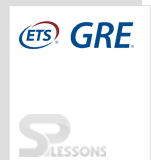 Introduction
Introduction
GRE General Test Quantitative Reasoning is primarily categorized into the below-mentioned topics. The GRE Data Interpretation category assesses the basic mathematical skills, understanding of the elementary mathematical concepts and ability to quantitatively reason and to model and solve problems with quantitative methods. The GRE Data Interpretation questions are primarily grouped together and refer to the same graph, table or other data presentation. The GRE Data Interpretation questions ask to interpret or analyze the given data. The GRE Data Interpretation questions may be Multiple-choice (Select One/ Select One or More) or Numeric Entry.
This article provides the detail information about the GRE Data Interpretation of GRE General Test.
- Arithmetic- The topics include properties and types of integers, such as divisibility, factorization, prime numbers, remainders and odd and even integers; arithmetic operations, exponents and roots; and concepts such as estimation, percent, ratio, rate, absolute value, the number line, decimal representation and sequences of numbers.
- Algebra- The topics include operations with exponents; factoring and simplifying algebraic expressions; relations, functions, equations and inequalities; solving linear and quadratic equations and inequalities; solving simultaneous equations and inequalities; setting up equations to solve word problems; and coordinate geometry, including graphs of functions, equations and inequalities, intercepts and slopes of lines.
- Geometry- The topics include parallel and perpendicular lines, circles, triangles - including isosceles, equilateral and 30°-60°-90° triangles - quadrilaterals, other polygons, congruent and similar figures, three-dimensional figures, area, perimeter, volume, the Pythagorean theorem and angle measurement in degrees. The ability to construct proofs is not tested.
- Data analysis- The topics include basic descriptive statistics, such as mean, median, mode, range, standard deviation, interquartile range, quartiles and percentiles; interpretation of data in tables and graphs, such as line graphs, bar graphs, circle graphs, boxplots, scatterplots and frequency distributions; elementary probability, such as probabilities of compound events and independent events; conditional probability; random variables and probability distributions, including normal distributions; and counting methods, such as combinations, permutations and Venn diagrams. These topics are typically taught in high school algebra courses or introductory statistics courses. Inferential statistics is not tested.
-
✦ Quantitative Comparisons
✦ Single-Answer Multiple-Choice
✦ Multiple-Answer Multiple-Choice
✦ Numeric Entry
✦ Data Interpretation
 Q.Types
Q.Types
GRE Data Interpretation - Question Types
Data Interpretation questions are grouped together and refer to the same table, graph or other data presentation. These questions ask test takers to interpret or analyze the given data. The types of questions may be Multiple-choice (both types) or Numeric Entry.
 Tips for DI
Tips for DI
GRE Data Interpretation - Tips
- Scan the data presentation briefly to see what it is about, but do not spend time studying all of the information in detail. Focus on those aspects of the data that are necessary to answer the questions. Pay attention to the axes and scales of graphs; to the units of measurement or orders of magnitude (such as billions) that are given in the titles, labels and legends; and to any notes that clarify the data.
- Bar graphs and circle graphs, as well as other graphical displays of data, are drawn to scale, so test takers can read or estimate data visually from such graphs. For example, test takers can use the relative sizes of bars or sectors to compare the quantities that they represent but be aware of broken scales and of bars that do not start at 0.
- The questions are to be answered only on the basis of the data presented, everyday facts (such as the number of days in a year) and test takers knowledge of mathematics. Do not make use of specialized information test takers may recall from other sources about the particular context on which the questions are based unless the information can be derived from the data presented.
 Samples
Samples
Question no 1 to 3 are based on the following data.
Annual percentage change in dollar of sales at five retail stores from 2006 to 2008
1. If the dollar amount of sales at Store P was $800,000 for 2006, what was the dollar amount of sales at that store for 2008?
| Store | Percentage change from 2006 to 2007 | Percentage change from 2007 to 2008 |
|---|---|---|
| P | 10 | -10 |
| Q | -20 | 9 |
| R | 5 | 12 |
| S | -7 | -15 |
| T | 17 | -8 |
-
A. $727,200
B. $792,000
C. $800,000
D. $880,000
E. $968,000
-
A. For 2008 the dollar amount of sales at Store R was greater than that at each of the other four stores.
B. The dollar amount of sales at Store S for 2008 was 22 percent less than that for 2006.
C. The dollar amount of sales at Store R for 2008 was more than 17 percent greater than that for 2006.






